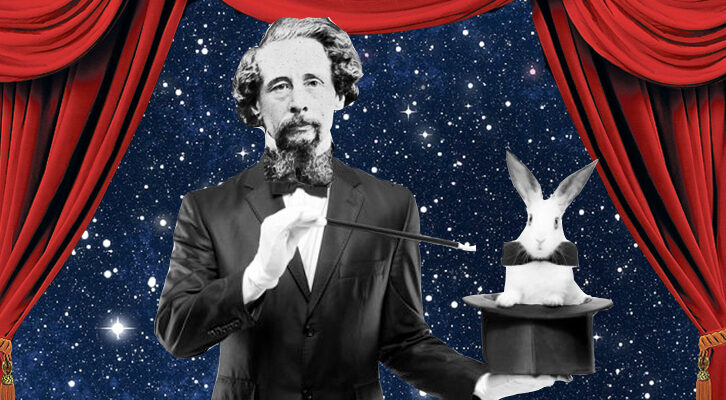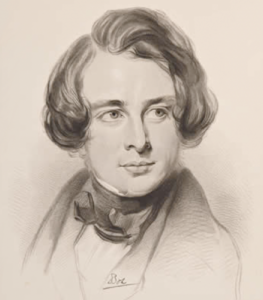
Charles Dickens was an amateur magician who often performed at his friends' kids' birthday parties.
Charles Dickens loved magic acts. He loved them. This should come as no surprise to those who know about his tendencies for showmanship—his highly theatrical public readings of selections from his novels or his collaborating on various plays and performances. But in December 1842, when he was thirty years old and already a five-time novelist of great repute, he decided that he wanted to spend his free time honing his interest in legerdemain, a hobby which would come to define the next decade of his life. In 1885, fifteen years after his death, Dickens’s daughter Mamie would speak about how her father “would very often, dressed as a magician, give a conjuring entertainment” when she was growing up.
The young Dickens made his debut on New Year’s Eve, at a party thrown by his friend John Forster. The two had “purchased between [them] the entire stock in trade of a conjurer” from Hamley’s Toy Store in London, with intent to put on a spectacular magic show for their friends. Dickens was giddy. Before arriving at Forster’s, he wrote to his friend C. C. Felton, “if you could see me conjuring the company’s watches into impossible tea caddies, and causing pieces of money to fly, and burning pocket handkerchiefs without hurting ’em,—and practicing [sic] in my own room, without anybody to admire—you would never forget it as long as you live.”
But this was a soft launch of his new act: his real debut was to be a week later on January 6th, the feast of the Epiphany but also the birthday of his oldest son, Charley, who was turning six years old. Dickens had planned an extravaganza for the little boy, and his surprise magic act was to be the centerpiece of the party. He had designed his routine, and picked an assistant, his friend Clarkson Stanfield, who was to pretend to be very silly and rather doltish.
 Dickens in 1842 at age 30
Dickens in 1842 at age 30
Evidently, the show was a rousing success, because a few weeks later, the wife of an acquaintance made Dickens promise to put on a magic show for her own children in February. Although only a few weeks had passed since Charley’s birthday party, Dickens had revamped his act for this new audience. Stanfield arrived to play the assistant, and the show was another success.
Eleven months later, he had his biggest engagement yet. On December 26th, 1843, he was invited to put on a magic show at the birthday party of Nina Macready—the daughter of the celebrated actor William Macready, who was away on tour. His friends Forster and Stanfield both joined the act, and this time, he stupefied his audience with the caliber of his tricks.
That evening, he transformed “a box of bran… into a live Guinea Pig” (which caused a stir when it ran off the stage and ran around audience’s feet). He “[produced] a pocket handkerchief from a Wine Bottle” as well as “a hot plum pudding… from an empty saucepan, held over a blazing fire, kindled in Stanfield’s hat, without damage to the lining.”
Jane Carlyle, the wife of well-known theologian and philosopher Thomas Carlyle, wrote to a friend afterwards, extolling the show: “Dickens and Forster above all exerted themselves till the perspiration was pouring down and they seemed drunk with their efforts! Only think of that excellent Dickens playing the conjurer for one whole hour—the best conjuror I ever saw—(and I have paid money to see several).” She added that his trick of producing the plum pudding in Stanfield’s hat “and his other of changing ladies’ pocket handkerchiefs into comfits and a box full of bran into a box full of—a live guinea-pig!—would enable him to make a handsome subsistence [and] let the bookseller trade go as it please!”
Although Dickens remained in the book business, he was still ramping up his act. A week after Nina’s party, in January of 1844, Dickens enlisted his brother Frederick in the procurement of elaborate costumes for him and Stanfield to wear during their performance at the following week’s Twelfth Night party.
But no performance was more sensational than the magic act he put on in the summer of 1849, at the family’s summer residence at Bonchurch on the Isle of Wight. For an audience of friends and family and “all the children in Bonchurch,” he appeared in the character of “The Unparalleled Necromancer Rhia Rhama Rhoos,” who had, according to the program, been “educated cabalistically [sic] in the Orange Groves of Salamanca and the Ocean Caves of Alum Bay.”
Most information about this performance would have been lost if Forster, who (following Dickens’s death) wrote a giant biography of him, had not transcribed the program from this event. Many of the tricks on the program—the program that Dickens had “of course drawn up by himself”— had been displayed before at Dickens’s other demonstrations, especially his (by-now) signature plum pudding trick. But many appear to be new. The program reads as follows:
THE LEAPING CARD WONDER.
Two Cards being drawn from the Pack by two of the company, and placed, with the Pack, in the Necromancer’s box, will leap forth at the command of any lady of not less than eight, or more than eighty, years of age.
*** This wonder is the result of nine years’ seclusion in the mines of Russia.
THE PYRAMID WONDER.
A shilling being lent to the Necromancer by any gentleman of not less than twelve months, or more than one hundred years, of age, and carefully marked by the said gentleman, will disappear from within a brazen box at the word of command, and pass through the hearts of an infinity of boxes, which will afterwards build themselves into pyramids and sink into a small mahogany box, at the Necromancer’s bidding.
*** Five thousand guineas were paid for the acquisition of this wonder, to a Chinese Mandarin, who died of grief immediately after parting with the secret.
THE CONFLAGRATION WONDER.
A Card being drawn from the Pack by any lady, not under a direct and positive promise of marriage, will be immediately named by the Necromancer, destroyed by fire, and reproduced from its own ashes.
*** An annuity of one thousand pounds has been offered to the Necromancer by the Directors of the Sun Fire Office for the secret of this wonder—and refused!!!
THE LOAF OF BREAD WONDER.
The watch of any truly prepossessing lady, of any age, single or married, being locked by the Necromancer in a strong box, will fly at the word of command from within that box into the heart of an ordinary half-quartern loaf, whence it shall be cut out in the presence of the whole company, whose cries of astonishment will be audible at a distance of some miles.
*** Ten years in the Plains of Tartary were devoted to the study of this wonder.
THE TRAVELLING DOLL WONDER.
The travelling doll is composed of solid wood throughout, but, by putting on a travelling dress of the simplest construction, becomes invisible, performs enormous journeys in half a minute, and passes from visibility to invisibility with an expedition so astonishing that no eye can follow its transformations.
*** The Necromancer’s attendant usually faints on beholding this wonder, and is only to be revived by the administration of brandy and water.
THE PUDDING WONDER.
The company having agreed among themselves to offer to the Necromancer, by way of loan, the hat of any gentleman whose head has arrived at maturity of size, the Necromancer, without removing that hat for an instant from before the eyes of the delighted company, will light a fire in it, make a plum pudding in his magic saucepan, boil it over the said fire, produce it in two minutes, thoroughly done, cut it, and dispense it in portions to the whole company, for their consumption then and there; returning the hat at last, wholly uninjured by fire, to its lawful owner.
*** The extreme liberality of this wonder awakening the jealousy of the beneficent Austrian Government, when exhibited in Milan, the Necromancer had the honour to be seized, and confined for five years in the fortress of that city.
Dickens’s conjuring performances seem to have been few and far between, after that, but he remained interested in the subject. He kept up correspondences with famous celebrated magicians and attended many magic shows well into the 1850s. In his biography, Forster notes that Dickens, despite being a master of prestidigitation, attempted to ingratiate himself as the assistant to a French magician “whom Dickens always afterwards referred to as the most consummate master of legerdemain he had seen.” Still,
“…the Frenchman scorned help, stood among the company without any sort of apparatus, and, by the mere force of sleight of hand and an astonishing memory, performed feats having no likeness to anything Dickens had ever seen done, and totally inexplicable to his most vigilant reflection. ‘So far as I know, a perfectly original genius, and that puts any sort of knowledge of legerdemain, such as I supposed that I possessed, at utter defiance.’ The account he gave dealt with two exploits only, the easiest to describe, and, not being with cards, not the most remarkable; for he would also say of this Frenchman that he transformed cards into very demons. He never saw a human hand touch them in the same way, fling them about so amazingly, or change them in his, one’s own, or another’s hand, with a skill so impossible to follow.”
Perhaps this intimidation is why Dickens seems to have given up up public conjuring, shortly thereafter. But by all accounts, he was, in Forster’s words, “a capital conjuror” and this is too-commonly unknown. Now you see it.
__________________________________
This post is a very truncated version of a portion from the first chapter of my doctoral dissertation.
All of the quotes included have been taken from:
Dickens, Charles. The British Academy/The Pilgrim Edition of the Letters of Charles Dickens. Vol. 3: 1842–1843. Ed. Madeline House, Graham Storey and Kathleen Mary Tillotson. Oxford: Oxford UP, 1974. Oxford Scholarly Editions Online
Dickens, Charles. The British Academy/The Pilgrim Edition of the Letters of Charles Dickens. Vol. 4: 1844–1846. Ed. Madeline House, Graham Storey and Kathleen Mary Tillotson. Oxford: Oxford UP, 1978. Oxford Scholarly Editions Online.
Forster, John. The Life of Charles Dickens, vol. 1. Boston: James R. Osgood & Company, 1875.
Olivia Rutigliano
Olivia Rutigliano is an Editor at Lit Hub and CrimeReads. Her other work appears in Vanity Fair, Vulture, Lapham's Quarterly, the Los Angeles Review of Books, Public Books, The Baffler, Bright Wall/Dark Room, Politics/Letters, The Toast, Truly Adventurous, and elsewhere. She has a PhD from the departments of English/comparative literature and theatre at Columbia University, where she was the Marion E. Ponsford fellow. She hosts the podcasst "Culture Schlock" at Lit Hub Radio. She is on instagram at @oldebean, twitter at @oldrutigliano, and bluesky at @oliviarutigliano.bsky.social.



















